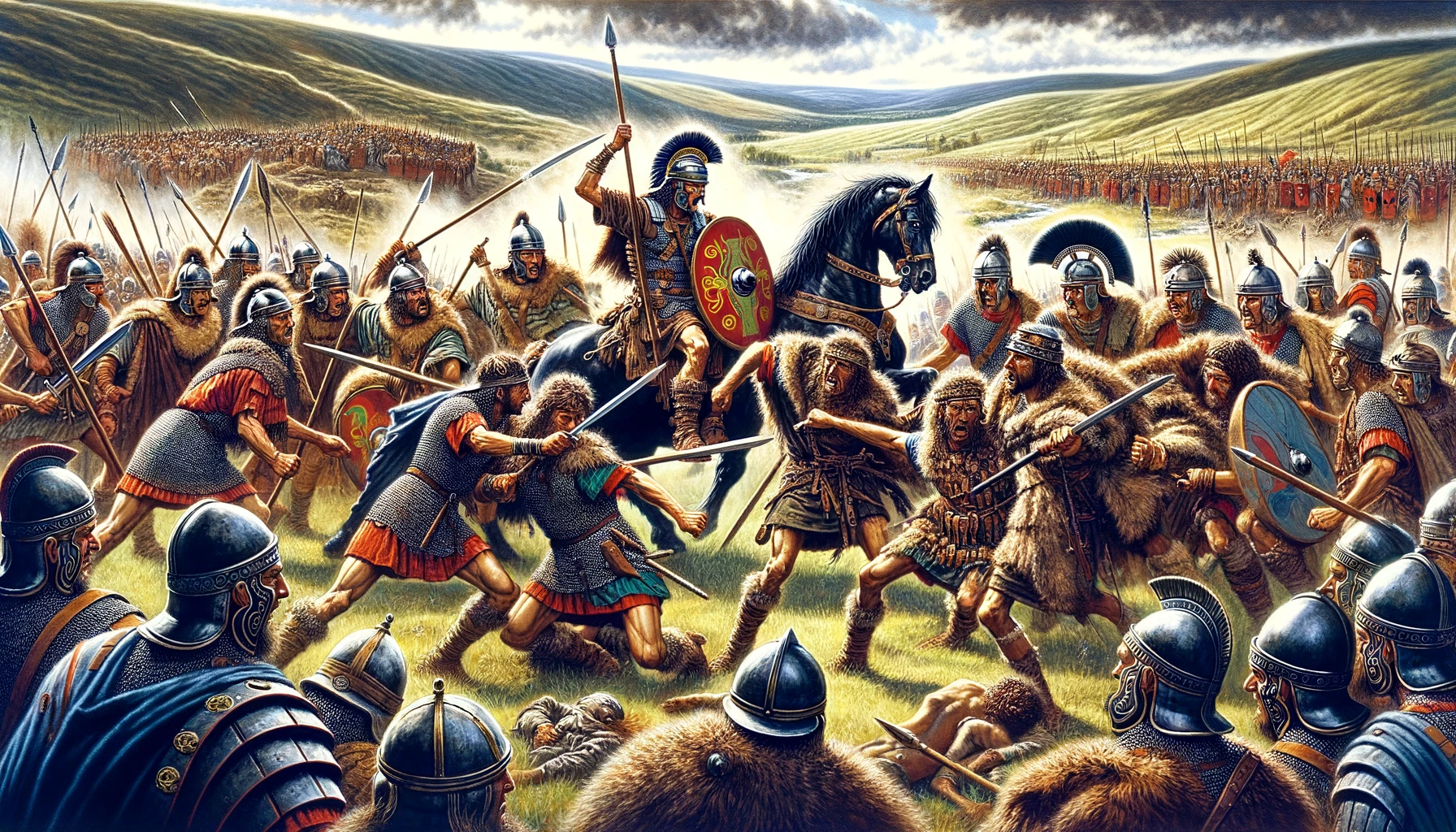During the governorship of Aulus Didius Gallus (52 – 57 AD) Cartimandua tired of her husband Venutius, divorced him and married his armour-bearer, Vellocatus. This move made Venutius the foremost leader of the resistance against Roman occupation. At first, he sought only to depose his former wife, but eventually, he turned his sights towards her Roman defenders. Venutius’ rebellion was eventually quashed by Caesius Nasica.
Cartimandua Breaks with her Consort, Venutius (52 – 57 AD)

In the Annals Tacitus mentions that the divorce of Cartimandua and Venutius the subsequent war which was waged during the governorship of Gallus (52 – 57 AD).
After the capture of Caractacus, Venutius of the Brigantes, as I have already mentioned, was pre-eminent in military skill; he had long been loyal to Rome and had been defended by our arms while he was united in marriage to the queen Cartimandua. Subsequently a quarrel broke out between them, followed instantly by war, and he then assumed a hostile attitude also towards us.
Cornelius Tacitus – The Annals, Book 12, Chapter 40
Tacitus gives us more details in his earlier work, Historiae.
[Venutius’] strongest motive was a private quarrel with Queen Cartimandua, a member of a powerful family, who ruled the Brigantes. Her authority had lately increased, since she had betrayed King Caratacus into the hands of the Romans, and was thus considered to have provided Claudius Caesar with material for his triumph. Thus she had grown rich, and with prosperity came demoralization. She threw over Venutius, who was her husband, and gave her hand and kingdom to his armour bearer, Vellocatus. This crime soon proved the ruin of her house. The people supported her husband: she defended her lover with passionate ferocity. Venutius therefore summoned assistance and, aided by the simultaneous revolt of the Brigantes, brought Cartimandua into dire straits.
Gaius Cornelius Tacitus’ The Histories, Book 3, 45
Cartimandua and Venutius were divorced after she gave up King Caratacus to the Romans in AD 51 and before 57 AD.
Who was Venutius?
Venutius was the consort of of Cartimandua and thought to have been a ruler of a tribe to the north
of Brigantia. After the capture of Caratacus, Venutius was the most outstanding of the Britons for his military skill and became the defacto leader of the resistance after his capture. After his rejection by Cartimandua, Venutius, probably retired to his former kingdom.
Brigantian reaction to Cartimandua’s affair
Cartimandua had been richly rewarded for her capture of Caratacus, this combined with her new close relationship with Rome, encouraged her to make a ill advised decision to divorce her husband and marry one of her husbands retainers, Vellocatus. Cartimandua decision to make Vellocatus her co-ruler, rather than treating the affair as a casual fling outraged and alienated many of her subjects, who were sympathetic to her estranged husband Venutius. While some have suggested that Vellocatus’ noble birth may have lessened the blow of Cartimandua’s actions, the reality is that her people were deeply offended and angered by her recklessness.
Cartimandua takes Hostages
Cartimandua showed cunning by taking Venutius’ brother and other relatives hostage. This strategic move placed Venutius in a challenging position. Nonetheless, he led a carefully chosen group of soldiers to invade Brigantia.
At first, however, they simply fought against each other, and Cartimandua by cunning stratagems captured the brothers and kinsfolk of Venutius. This enraged the enemy, who were stung with shame at the prospect of falling under the dominion of a woman. The flower of their youth, picked out for war, invaded her kingdom.
Cornelius Tacitus – The Annals, Book 12, Chapter 40
It appeared that Venutius was hesitant to engage in a full-blown war and so attempted to free the hostages with a select group of young warriors, rather than a full scale invasion, in order to antagonise Cartimandua’s Roman allies.
Rome send aid to Cartimandua
Cartimandua had foreseen Venutius’ actions and had asked Gallus for his help in guarding her prisoners.
The possibility of a war erupting on the northern frontier while the western frontier was already under constant threat must have been a source of great concern for Didius Gallus. Despite probably perceiving Cartimandua as an unpredictable woman who could create significant issues for them, it was in the best interest of Rome to support Cartimandua’s reign for as long as feasible.
We again have slightly different descriptions of events from Tacitus, in the Histories and the Annals.
[Cartimandua] petitioned for troops from Rome. Our auxiliaries, both horse and foot, then fought several engagements with varying success, but eventually rescued the queen. Thus the kingdom was left in the hands of Venutius and the war in ours.
Gaius Cornelius Tacitus’ The Histories, Book 3, 45
This we had foreseen; some cohorts were sent to her aid and a sharp contest followed, which was at first doubtful but had a satisfactory termination.
Cornelius Tacitus – The Annals, Book 12, Chapter 40
This is the first reference to a battle between Cartimandua and Venutius, in which some cohorts were dispatched.
The legion under the command of Caesius Nasica fought with a similar result.
Cornelius Tacitus – The Annals, Book 12, Chapter 40
Another conflict, this time with the Legio IX Hispana, which would suggest a larger force mustered by Venutius, this had similar results. The involvement of a legion would suggest the use of legionary sized marching camps for campaigns greater than twenty miles inside Brigantia.
For Didius, burdened with years and covered with honours, was content with acting through his officers and merely holding back the enemy.
The above extract seems to describe two distinct phases: the primary objective of maintaining Cartimandua’s position on the throne and the secondary aim of thwarting Venutius’ attempt to seize the hostages.
Tacitus clearly states that Venutius aimed his hostility towards Rome – “etiam adversus nos hostilia induerat”. This implies that a battle ensued between the hostile Britons and Legio IX, with the outcome initially uncertain before the Romans ultimately emerged victorious. This resembles the prior engagement with the auxiliary cohorts.
A number of auxiliary cohorts were dispatched to prevent the hostage-taking. Although there was a fierce battle, it proved inconclusive until a legion under the command of Caesius Nasica, likely Legio IX, was called upon to intervene. After the legion’s involvement, the threat was eventually eliminated. Notably, the headquarters fortress for Legio IX was still stationed at Longthorpe, close to Peterborough.
The immediate consequence of these events would have been swift modifications to the old Plautian frontier, which was established along the Trent River. Additionally, troops had to be relocated to positions closer to the stronghold of the Brigantian queen.
Where was Cartimandua’s Stronghold?
Surprisingly, there are very few hill-forts in Brigantia that follow the Wessex-north Wales patterns. It remains possible that the queen’s royal palace was located in a settlement that was not fortified with massive earthworks. While one might expect the site of the cantonal capital, Isurium Brigantum (Aldborough), to be an obvious choice, there is little evidence of any pre-Roman occupation there. The Romanised town, which is situated in the fertile Vale of York, occupies a commanding position. Given this, it is difficult to believe that the area was not extensively cultivated during the late Iron Age. Some scholars have recognized the significance of the fertile Ouse Valley or it may have been near York, based on the pre-Roman name of the city, while other suggest Barwick-in-Elmet, is a 15-acre hill-fort at the east end of the Aire Gap.
Rigodunum, a place-name listed by Ptolemy as a polis of the Brigantes, could serve as a valuable clue. Its meaning, ‘royal fort,’ suggests that it may have been a significant centre of power for the Brigantes. Rigodunum has been associated with the Roman fort located at Castle Shaw, situated on the major cross-route from Manchester to York through the Pennines. The next fort at Slack Roman Fort, ten miles to the north-east, has been linked with Cambodunum mentioned as a station on this route in the Antonine Itinerary.
